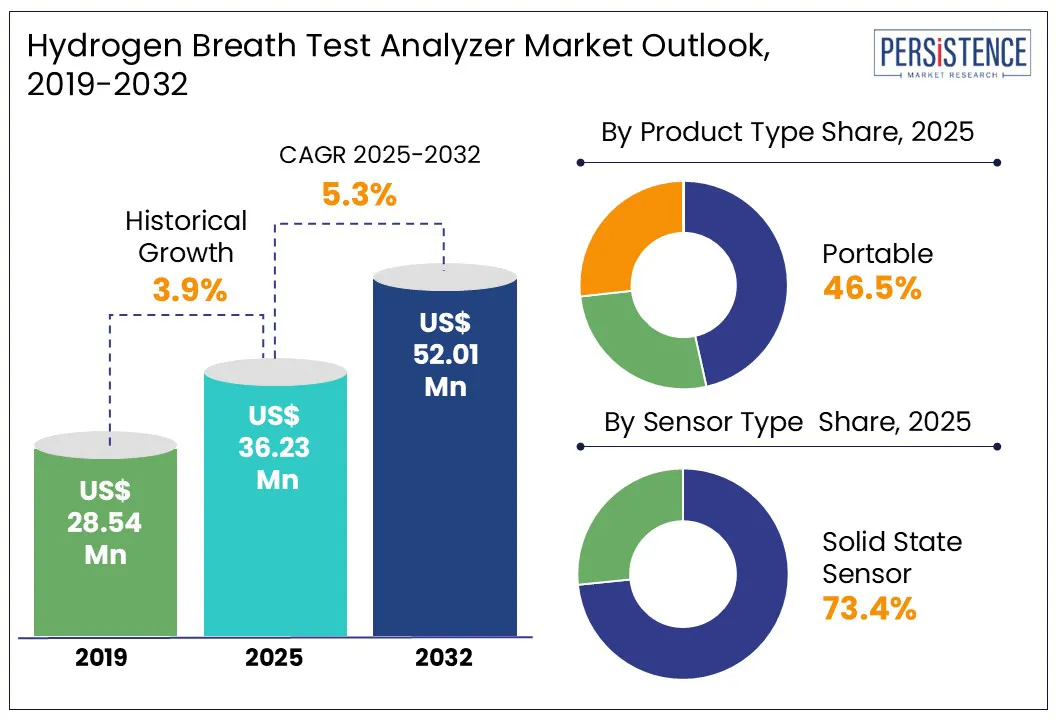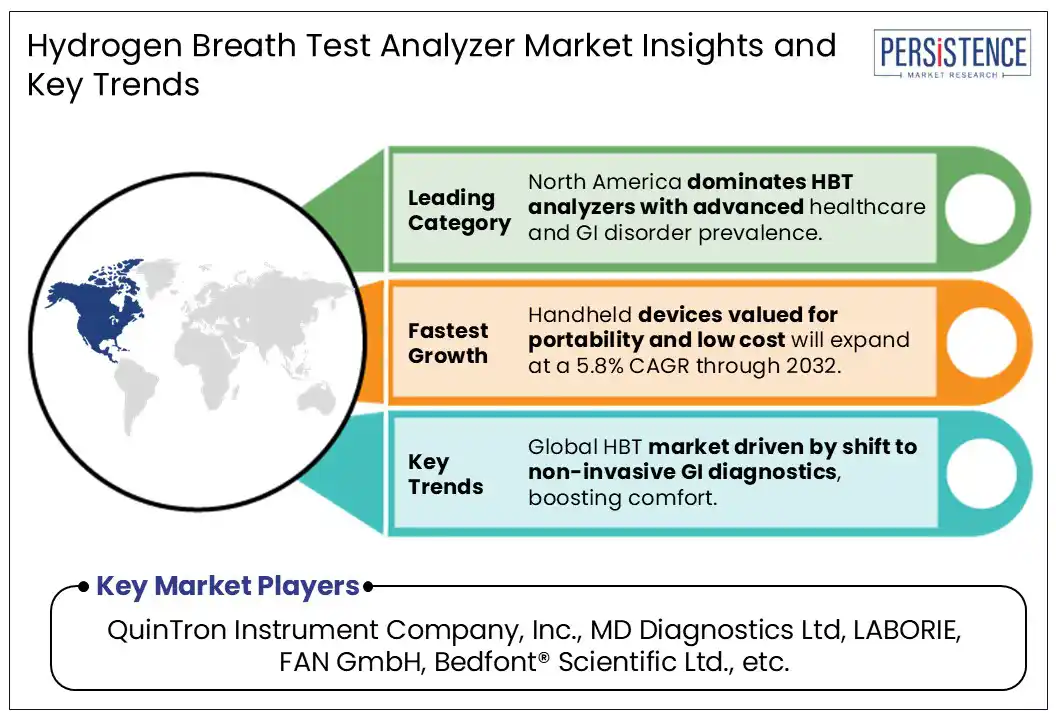ID: PMRREP22903| 200 Pages | 1 Jul 2025 | Format: PDF, Excel, PPT* | Healthcare

The global hydrogen breath test analyzer market size is likely to reach a value of US$36.23 million in 2025 and is expected to attain a value of US$52.01 million by 2032, growing at a CAGR of 5.3% from 2025 to 2032.
Breath testing, which analyses the presence of different gases in a patient's breath, is a non-invasive method of identifying a variety of metabolic illnesses. Hydrogen breath tests are frequently used to explore the pathophysiology of metabolic gastrointestinal (GI) disorders. Small intestine bacterial overgrowth (SIBO) and carbohydrate malabsorption are the two major illnesses that hydrogen breath tests can identify. The increased prevalence of chronic indigestion that causes bacterial growth in the colon eventually produces hydrogen gas and is a major factor driving the growth of hydrogen breath test analyzer market.

Key Industry Highlights
|
Global Market Attribute |
Key Insights |
|
Hydrogen Breath Test Analyzer Market Size (2025E) |
US$ 36.23 Mn |
|
Market Value Forecast (2032F) |
US$ 52.01 Mn |
|
Projected Growth (CAGR 2025 to 2032) |
5.3% |
|
Historical Market Growth (CAGR 2019 to 2024) |
3.9% |
The rising incidence of various gastrointestinal (GI) disorders, including those leading to symptoms such as fecal incontinence, is expected to significantly boost the demand for hydrogen breath test analyzers. These non-invasive diagnostic tools are increasingly favored for their accuracy and patient comfort.
The growing prevalence of GI illnesses is affecting millions globally and directly contributing to the market expansion. Functional gastrointestinal disorders (FGIDs), such as irritable bowel syndrome (IBS), small intestinal bacterial overgrowth (SIBO), lactose intolerance, and fructose malabsorption are among the most diagnosed conditions. For instance, in 2019, there were approximately 2.28 billion prevalent cases of digestive diseases worldwide. Functional gastrointestinal disorders (FGIDs), such as irritable bowel syndrome (IBS), affect up to 40% of the global population. Specifically, IBS impacts about 10%-15% of adults in the United States. This increasing disease burden is expected to be a major driver for the global hydrogen breath test analyzer market throughout the forecast period.
One of the major restraint in the hydrogen breath test (HBT) analyzer market is the lack of standardized interpretation guidelines across different test types and regions. Despite the widespread use of HBTs for diagnosing conditions such as lactose intolerance and small intestinal bacterial overgrowth (SIBO), clinical interpretation can vary significantly. Differences in test substrates, durations, cutoff values for hydrogen levels, and sample collection timing often lead to inconsistent or inconclusive results.
This variability may cause misdiagnosis or underdiagnosis, reducing clinician confidence and limiting wider adoption. Moreover, the absence of a global consensus on diagnostic thresholds makes it difficult to compare results across studies or regions. As a result, healthcare professionals may hesitate to rely solely on breath testing, opting instead for additional or alternative diagnostic methods. This inconsistency ultimately hampers market growth by affecting test reliability and reducing the perceived value of hydrogen breath analyzers in clinical practice.
In recent years, advancements in the health care sector have had a big impact and brought about significant changes, such as transitioning from invasive to non-invasive therapies and using hydrogen breath test analyzers for identifying lactose intolerance in patients suffering from gastrointestinal diseases. The exhaled hydrogen breathing test is becoming an essential non-invasive and early diagnostic technique for assessing illnesses and health issues. Breath tests have several benefits over traditional medical testing, including low cost, non-invasive nature, and safety. Moreover, because of the revolution in sensor technology, Electrochemical sensors are being used to detect several harmful gases in ppm ranges. Major market players are developing multifunctional devices that can monitor and diagnose hydrogen, methane, other gases, and SIBO to advance in this field. Technological advancements are likely to be a major factor driving the growth of the global hydrogen breath test analyzer market.
The market is primarily segmented into portable and handheld analyzers, both of which are gaining traction due to their ease of use and high diagnostic accuracy. Portable analyzers are often used in clinical settings and conduct tests for up to ten patients in a single session, making them efficient for group testing or high-throughput environments. Handheld devices are compact, lightweight, and low-power, requiring minimal accessories, which enhances patient compliance and reduces the burden on healthcare staff. These cost-effective solutions also support decentralized testing, decreasing the need for frequent hospital visits and aligning with the growing trend of home- and point-of-care diagnostics.
In the hydrogen breath test analyzer market, solid-state sensors hold the largest market share and are also projected to witness the fastest growth during the forecast period. These sensors are preferred due to their high sensitivity, compact size, and long operational life. Solid-state sensors operate efficiently across a wide temperature range and require minimal maintenance, making them ideal for both clinical and home-based diagnostic use. Their robust design enhances device durability and reliability, which further boosts their adoption in various healthcare settings.
On the other hand, electrochemical sensors, while effective, are often limited by shorter lifespans and higher sensitivity to environmental conditions. However, they still serve a vital role in cost-effective models and emerging markets. The increasing demand for accurate, quick, and user-friendly diagnostic tools is driving innovation in sensor technology, with solid-state sensors becoming the preferred choice due to their superior performance and compatibility with portable and handheld hydrogen breath analyzers.

The hydrogen breath test analyzer market is highly competitive with the presence of several big players. Manufacturers in the hydrogen breath test analyzer market are implementing various strategies to increase their market share and expand their product offerings. The key players in the market for hydrogen breath test analyzers are also focusing on new marketing and distributing strategies to increase their geographical footprint in the global market.
The global market is estimated to increase from US$ 36.23 million in 2025 to US$ 52.01 million in 2032.
The global market is driven by rising gastrointestinal disorders, preference for non-invasive tests, and growing healthcare awareness.
The market is projected to record a CAGR of 5.3% during the forecast period from 2025 to 2032.
QuinTron Instrument Company, Inc., MD Diagnostics Ltd, LABORIE, FAN GmbH, Bedfont® Scientific Ltd., and Others.
Market opportunities include emerging markets expansion, portable device demand, multifunctional analyzers, telemedicine integration, and rising patient preference for early diagnosis.
|
Report Attribute |
Details |
|
Historical Data/Actuals |
2019 - 2024 |
|
Forecast Period |
2025 - 2032 |
|
Market Analysis Units |
Value: US$ Mn, Volume: As applicable |
|
Geographical Coverage |
|
|
Segmental Coverage |
|
|
Competitive Analysis |
|
|
Report Highlights |
|
|
Customization and Pricing |
Available upon request |
By Product Type
By Sensor Type
By Application
By End-User
By Region
Delivery Timelines
For more information on this report and its delivery timelines please get in touch with our sales team.
About Author